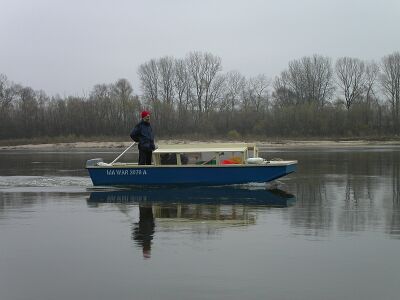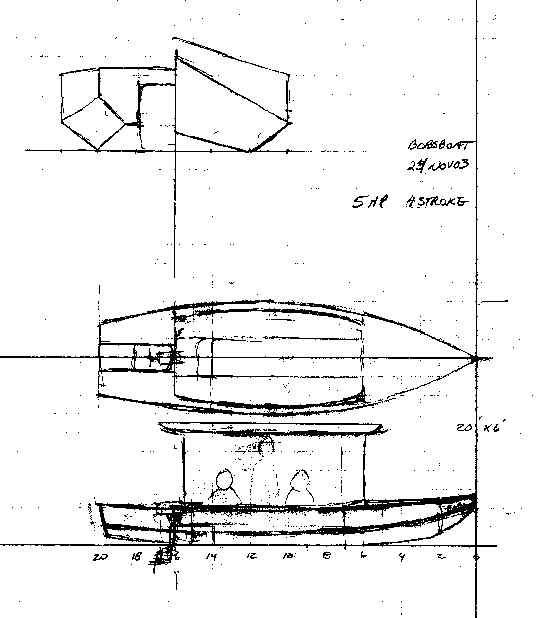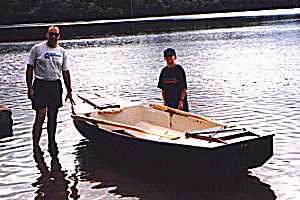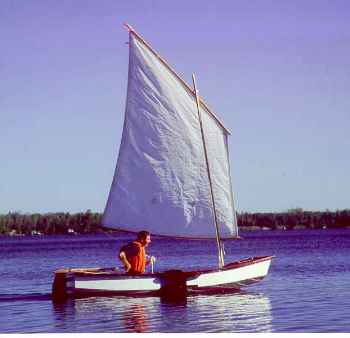
Wojtech again in Poland last autumn. Looks like a PVC pipe tiller extension that works so well.
Contents:
Contact info:
Jim Michalak
118 E Randall,
Lebanon, IL 62254Send $1 for info on 20 boats.
Jim Michalak's Boat Designs
118 E Randall, Lebanon, IL 62254
A page of boat designs and essays.
(15mar05) This issue will continue the boat design essays. The 1 April issue will rerun the essay on joining plywood sheets.
THE BOOK IS OUT!
BOATBUILDING FOR BEGINNERS (AND BEYOND)
is out now, written by me and edited by Garth Battista of Breakaway Books. You might find it at your bookstore. If not check it out at the....ON LINE CATALOG OF MY PLANS...
...which can now be found at Duckworks Magazine. You order with a shopping cart set up and pay with credit cards or by Paypal. Then Duckworks sends me an email about the order and then I send the plans right from me to you.
Drawing Boats 4
BACK TO THE BOBSBOAT DESIGN...

Let's take a quick guess at its displacement using the prismatic coefficient method discussed last time. We will put the draft at 9" which is where the chines and stern will start to immerse. I would expect the boat to go fairly well up until that point, then it will slow dramatically. Here is the endview:

First we will construct a "prism" with a length as long as our waterline when the draft is 9". I will estimate that as 18'. Then the prism will have the same cross section as this boat's maximum underwater cross section. So that cross section will have as shown above a bottom 4' wide and a top 6' wide and a depth of .75' deep (9" draft). That cross sectional area is .5x(4+6)x.75=3.75 sq ft. And the total prism volume would be 3.75 x 18 = 67.5 cubic feet. Now apply a "prismatic coefficient" of .55 as discussed in the last issue and we would estimate a max useful displacement for Bobsboat of 67.5 x .55 = 37 cubic feet of water, which is 37 x 62 = 2300 pounds.
That I think is quite a lot. I would at this time estimate an empty weight of the hull at perhaps 500 pounds and maybe another 100 pounds for the motor. Add four adults at say 700 pounds total and you are looking at about 1200 pounds total. So there is quite a surplus. One thing I must remember is that this boat is to have its motor mounted inboard in a slot that will eliminate a triangular shaped volume of water that is 4' long, maybe 2' wide, and 9" deep which eliminates about 180 pounds of displacement. Anyway, the important point is that we have enough and if someone wants to take on more folks the boat will handle it.
Always do this sort of calculation as soon as you can. For example if this were to be a ballasted sailing cabin boat you might increase hull weight to maybe 700 pounds and then add 700 pounds of ballast and have a starting weight of 1400 pounds before adding any people or gear. (It should still work.)
MIGHT AS WELL TRY A COMPUTER MODEL...
At this stage you will do well to make a computer model using something like the Hullform program. You should be able to download a free demo version of the program which will suffice for this work by clicking on the Hullform link at the bottom of this web issue. Hullform is not an "instant" sort of program. You will have to supply it with the information needed to define the hull shape of your boat - no program could do any serious work without that.
So I go back to the line drawings that I made a few issues ago and measure offsets at every two feet, plus another set at station 11 of this 20' hull so I have a section at the hull's maximum beam. Then I call up Hullform and start a model and start plugging in those offsets. Eventually you will get pretty good at it and be able to knock out a useful model in a half hour or so. Here is my Hullform model of Bobsboat:

Looks like a boat to me. The graphics will show you big goofs in your offsets but maybe not small goofs. I'm not sure how fine the grid needs to be but I'm quite sure that having ten or so stations is plenty to get a good handle on the numbers. I did not model in the motor slot but I'm sure it can be done. Hullform was I think meant for serious ship design and is not challenged much by this small boat. The version I use most was written for DOS, that is it is older than Windows. It runs very quickly on any computer. I would suspect the newer versions require more power and have a lot more graphics.
But even the free demos will allow you to see your hull in three dimensions, even will shade things to a certain degree, like this:

And this:

Still looks like a boat to me and I see no need to change anything.
PUTTING HULLFORMS TO WORK...
Pictures are nice but Hullform will do some real quick work for you. Again you need to supply it with all the info it needs to do that work, such as weight and center of gravity. At this stage you will have to guess at those.
So I used the above model to check on the displacement calculations. Essentially you tell Hullform the boats weight and cg location and it will tell you the draft needed and how much the boat is pitching. Usually we want the boat to sit level when loaded so I found by a few trials that this hull wants its weight centered 11' from the bow to float level. That is fine since it is also the max beam location. (The real boat, with the motor slot, will want its weight more forward.) Once you have that cg location for level trim you can plug in a few weights and just read off the resulting drafts. Here is what I got for Bobsboat:
500 pounds - 3.4" draft (probably the weight of the empty boat).
800 pounds - 4.5" draft (probably the minimum operating weight with skipper and motor).
1000 pounds - 5.2" draft
1200 pounds - 5.8" draft (a good maximum weight, say four adults on board).
2400 pounds - 8.96" draft (is that close to our first guess or what!)
I should add that at this point the program has not really solved much that we weren't able to figure by hand quickly. But Hullform will also very quickly solve the problem of righting moments at various angles of heel and that if done by hand is almost a life's work. Doing those calculations by hand is so tedious that essentially it was never done for small boats. In the example Bobsboat, which should also be a fine sailing hull, the program would also need to know the vertical cg location. Once supplied with the hull shape and the total weight/cg situation, Hullform will crank out a full righting moment graph in a few seconds! (But don't get the idea that you can supply it with a weight/cg estimate in a few seconds.)
ANOTHER FEATURE...
that I noticed in the newer demos is the ability to give a chart of drag/speed for your proposed hull. I'm don't really know the source of the math behind the estimates. You may recall that a couple of years back I built a "Thrustometer" and measured the thrust of a few of my outboards while they were pushing my AF4. Then I compared those thrusts to the Hullform estimates. The comparison was OK, a good starting point I think. Here is the proposed chart for Bobsboat:

When I look at this I see what all slow speed hulls experience - a "hull speed". As you see, drag rises very quickly at about 5 knots. The usual estimate for "hull speed" in knots is something like 1.3 times the square root of the waterline length (in feet). So if we had an 18' waterline then we would estimate 1.3 x sqrt18 = 5.5 knots. And the above chart sort of agrees with that. I'm not sure if we have gained a lot of new information but it is worth while to look at. Hullform will make curves for a range of weights (the above is for 1200 pounds).
Some day I'd like to be able to use the above charts to get a handle on horsepower requirements, a task we tried back with the Thrustometer. If you look at the above there would be a temptation to say, "Hey, a 30 pound thrust trolling motor will push this at 5 knots." And that might be true. But in any breeze the wind drag will quickly outrun the water drag and you will get nowhere or go backwards. From my experience with Birdwatcher, the answer to powering all boats like this is that you need between three and five hp. BW went 6mph with my 3.5 Clinton wide open and about 6mph with my 5.5 Johnson wide open. From the above chart you can see why - the slope of the drag curve is so steep at the "hull speed" that a lot more power gives only a little more speed. That would be true until the boat starts to "plane". In the above chart you see the black line which is the start of the planing line. Somewhere in between the red line and the black line there is a transition. But a hull with a fine stern like Bobsboat or Birdwatcher really won't plane well at all as far as hull trim and controlability are concerned and you should not think of planing that type of hull. The extra power of the 5.5 on Birdwatcher has a real advantage in that I can run at say 4knots at a whisper quiet third throttle in calm conditions and still have some extra to fight the bad conditions.
When we come back to Bobsboat in April we will start the hard core drafting - determining the prefab shapes of the panels.
NEXT TIME...
We'll rerun the article on joining plywood sheets.
PICCUP PRAM

PICCUP PRAM, SAIL/ROW PRAM, 11' X 4.5', 90 POUNDS EMPTY
Piccup Pram was the first boat of my design to get built, back in 1990, I think. I still have the prototype and use it regularly. I designed it to be the best sail/row boat I could put in the back of my short bed pick up truck. But I found it to be a good cartopper, too. It has capacity and abilities I had previously thought impossible in a 90 pound cartopper. The photo above shows the original 55 square foot sail on Pensacola bay a long time ago. Piccup is a taped seam multichine hull which can take a fair amount of rough water.
Piccup continues to be one of my most popular designs and I get nice photos from builders. Here is one of Richard Donovan hoping for more wind up in Massachusetts.

Richard's Piccup has the larger 70 square foot sail that prefer myself. It's the same as the original but is 2' taller. This balanced lug sail sets on a 12' mast and rolls up easily for storage on its 9' yard and boom. The idea was to be able to store the rig easily in the boat during rowing and it works. There is a pivoting leeboard and kickup rudder on the boat and they can be left in place raised while rowing. Converting to full sail takes a couple of minutes as you step the short mast, clip on the halyard and tack lines, hoist the sail, lower the boards, and off you go. And the balanced lug sail reefs very well although reefing any small boat is best done on shore.
Here is a Piccup by Vince Mansolillo in Rhode Island, a nice father/son project. Piccup will be large enough to hold both of them. You can see the large open frameless cockpit, large enough for sleeping. And you see the buoyancy/storage boxes on the end.

But Piccup will take two adults as seen in the photo of Jim Hudson's boat. Jim's boat has a polytarp sail as does my own Piccup.

These boats have proven to be good for sail rig tinkerers (be sure to read and apply the Sail Area Math essay before starting). Here I am in Piccup with a polytarp sharpie sprit sail. The rig is different from the originals but the hull here is totally unchanged (except for paint) from the original shown on the beach at Pensacola.

I think my own Piccup has had about six rigs of different sorts and was always the test bed for the polytarp sail experiments. But, hey!, that's nothing compared to the tinkering Reed Smith did with his out in California. Here is his Piccup rigged as a sharpie sprit yawl!

Here is Rob Rhode-Szudy's yawl rig Piccup that was featured in his essays about building Piccup that you can access through the old issue links.

Here is another by Doug Bell:

This one is by Jim Islip:

And this one by Ty Homer:

Piccup Pram uses taped seam construction from five sheets of 1/4" plywood.
Plans for Piccup are still $20.
Prototype News
Some of you may know that in addition to the one buck catalog which now contains 20 "done" boats, I offer another catalog of 20 unbuilt prototypes. The buck catalog has on its last page a list and brief description of the boats currently in the Catalog of Prototypes. That catalog also contains some articles that I wrote for Messing About In Boats and Boatbuilder magazines. The Catalog of Prototypes costs $3. The both together amount to 50 pages for $4, an offer you may have seen in Woodenboat ads. Payment must be in US funds. The banks here won't accept anything else. (I've got a little stash of foreign currency that I can admire but not spend.) I'm way too small for credit cards.
The AF4G is done and launched. Writeup after testing:

Garth has the big Cormorant project to the point where he can run power to it and set it up with a mattress and TV set and Mr Coffee and make it a hangout for the New York winter!

The out West Picara has its roof and some major sail rig bits done:

The down South Picara is getting its innards done.

This long and lean project is a 19' version of Toon2. I don't have the drawings done yet. The builder is working from preliminary drawings and is about to pass me up. MDO plywood looks like cardboard now but it isn't.

The prototype River Runner is complete but the builder sent some nice "in work" photos that I hope to run. Here he has assembled the prefabbed parts.

We have an experienced builder starting a Mayfly16:

AN INDEX OF PAST ISSUES
Hullforms Download (archived copy)
Plyboats Demo Download (archived copy)
Brokeboats (archived copy)
Brian builds Roar2 (archived copy)
Herb builds AF3 (archived copy)
Herb builds RB42 (archived copy)